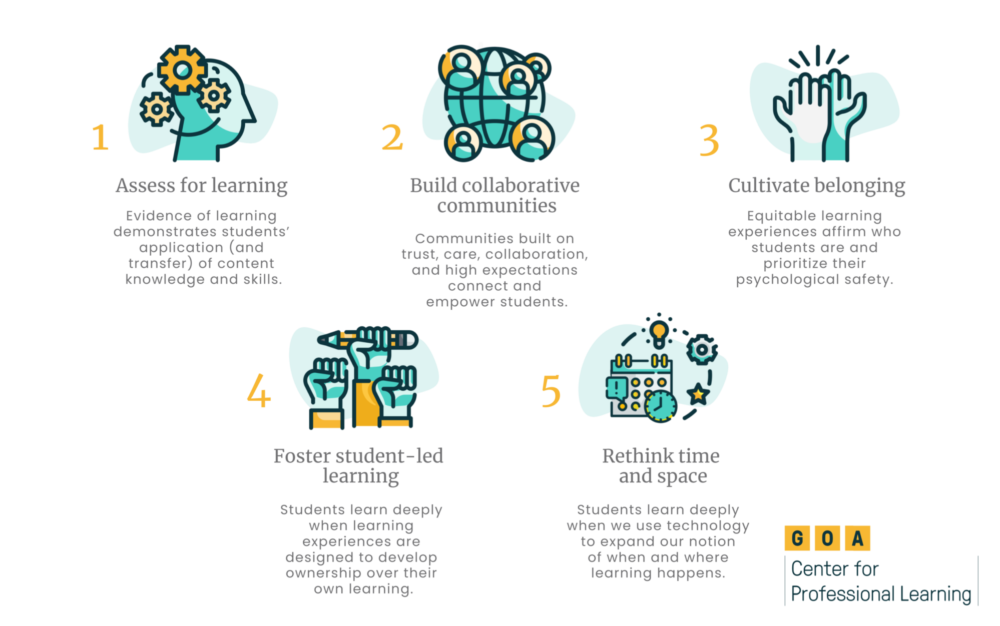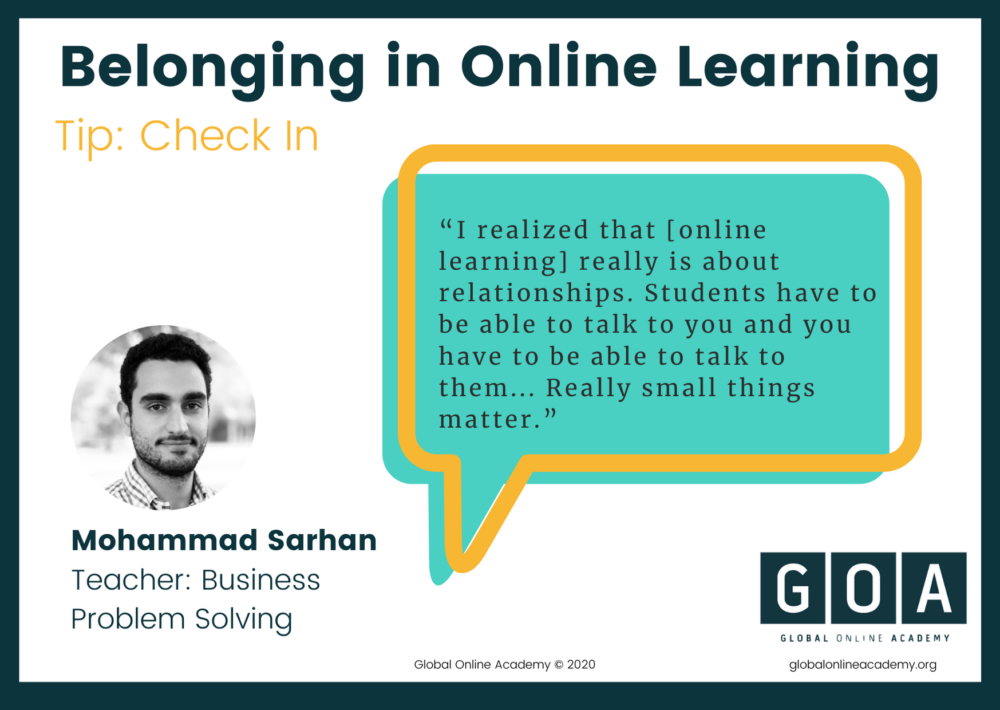How to Cultivate Belonging: Shifts and Strategies for Teachers
"We can’t do anything, we can’t take risks, we can’t breathe freely without feeling like we belong. So if we really truly believe that all children should succeed, all children should thrive, then we have to start with belonging." - Dr. Dena Simmons
Equitable learning experiences affirm who students are and prioritize their psychological safety in the classroom environment, whether online or in-person. Designing for belonging begins with intention. At GOA, we have articulated five educator competencies as our new professional learning framework. These competencies are applicable for K-12 educators and are for teachers who teach in-person, online, or in hybrid learning environments. The educator competencies reflect skills that are essential to equitable teaching practices and can be seen in the image below. Cultivate Belonging is one of the five competencies teachers should know and be able to do. This is a critical skill that educators can develop and sharpen to ensure their students feel supported and are able to engage deeply in their learning.

GOA's Educator Competencies
The importance of cultivating belonging in academic settings is not new. However, as the pandemic has endured and some students have left classrooms altogether, and as some schools and students are transitioning back to fully in person learning after over a year of learning online, it’s urgent to re-prioritize the importance of belonging. As my colleague Ellen Min Hartman recently wrote in her article, Prioritizing Student Wellness: How Online Learning Can Help, “In the past 18 months, adolescents not only felt the effects of the pandemic, but also the impact of economic challenges, inequities in vaccine distribution, and political tensions around racism, mask mandates, and anti-racist curricula.”
Belonging is also an environmental condition, so teachers and leaders have a responsibility to, through intentional shifts and strategies, create conditions where students experience a sense of belonging and psychological safety. In a recent ASCD publication, Moving from Absent to Present, the authors write, "Perhaps the most important takeaway from research, though, is that student engagement is often an environmental condition, not a student characteristic. Thus, it's relatively easy to change. Although approximately three million U.S. students may have stopped attending school when the pandemic began, all hope is not lost. While systemic issues or challenges involving technology access, family situations, or lack of resources are often involved in student absenteeism, educators can often play a role in re-engaging students by supporting them, making them feel connected to the classroom environment, and helping them move from absent to present.”
What cultivating belonging looks like in action
Cultivating belonging is a priority, and it’s important that teachers know it’s valuable to spend time on this in the classroom, even at the expense of content coverage. These strategies can be formally constructed and designed, but it is also important to leave time for informal, spontaneous, and personal connections.
At its most essential, when we cultivate belonging, we must:
Design for human connection.
Ensure content represents a diversity of perspectives.
Prioritize student voice in interactions and assessments.
Below, we share ways in which teachers have shaped or shifted routines, language use, or practices and describe what cultivating belonging looks like in action.
Design for human connection
Create morning routines. As a morning routine, students share a daily affirmation as their teacher welcomes them to class. Check out Daily Affirmations.
Pay attention to your greetings and your goodbyes. Kindergarten educator Lauren Paige shares why she has moved away from greeting students this way. See: Shifting away from "Good morning, boys and girls."
Learn, remember, and pronounce student names correctly. Teachers' Strategies for Pronouncing and Remembering Students' Names Correctly. This article elevates the importance of pronouncing names correctly as well as strategies to do so.
Center relationships and care in your teaching practice. For example, Facing History and Ourselves features excellent strategies for cultivating belonging using a framework of Connectedness, Predictability, Empowerment, and Flexibility.
Check-in. Mohammad Sarhan, an educator at King’s Academy, creates a sense of belonging for his students: “I realized that [online learning] really is about relationships. They have to be able to talk to you and you have to be able to talk to them. It doesn’t even have to be crazy conversations. Just checking on someone. Really small things matter.” You can read more about how to cultivate belonging in online settings here.

Ensure content represents a diversity of perspectives
Consider how we ask questions in surveys. For example, these 13 questions by MAPSO Freedom School inspired by Dr. Gholdy Muhammad's Cultivating Genius Equity Framework and this pre-course survey guidance from OneHE.
Emphasize usability, accessibility, diverse and inclusive representation in your design. The GOA Online Course Style Guide emphasizes the importance of reducing cognitive load in navigation and ensuring that students can bring more of themselves to the learning experience.
Extend beyond icebreakers. We like OneHE's Equity Unbound Community Building Activities and intentionally equitable hospitality which feature activities that ensure diversity of perspectives.
Prioritize student voice in interactions and assessments
Invite student voice. These are two example prompts from GOA courses.
Provide warm, wise feedback. This resource, Warm, Wise Feedback that supports Growth Mindset + Ability + ACTION, shares how we can shift our language and our feedback to prioritize growth mindset and avoid the risk of stereotype threat. It is also equally important to teach students how to give and receive feedback.
It’s important to note that across all five of GOA’s educator competencies, we are never “finished” nor do we ever fully “arrive.” Much like our competency-based approach to teaching students, educators are also lifelong learners with a goal of continual improvement. We can make shifts and share our successes and our work with colleagues to build a culture of learning and improvement at our schools. As educators, we are continually growing, responding, shifting, and trying. And it’s important to note that cultivating belonging is an urgent starting point if we want to lay a solid foundation for the other competencies that help us grow and improve as educators, with the goal of improving student learning outcomes.
GOA offers multiple professional learning opportunities to support and empower educators to cultivate belonging in their courses and classrooms, whether they teach online or in-person:
Facilitated workshops including How Might We Humanize Online Spaces and How Might We Design for Inclusion?
